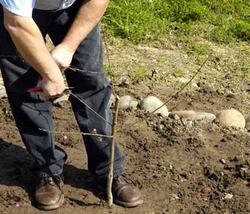We sell our products to retail nurseries, garden centers, container growers who sell to landscape contractors and retail nurseries, mail order nurseries, and anyone else who qualifies. We do not accept direct sales to consumers.
For Home Orchards
Plant bare root trees in Zones 6-10. Cut smaller whips back to knee-high; for larger trees cut primary branching back by two-thirds. Water new plantings thoroughly to eliminate air pockets from the soil around the roots. In the absence of precipitation after initial soaking, water lightly once a week. Dormant trees will not require much water until leaves emerge. Overwatering will drown new roots that are trying to form.
In warmer climates, fruit trees will begin to bloom and leaf this month. Consider top dressing with trace minerals to start the year off right. Turn over a shallow (3-4") trench around the drip line of the tree; sprinkle a balanced trace mineral product that offers calcium, iron, manganese, copper and zinc. Replace the soil and if rain is absent, water thoroughly.
Every planting site is unique; temperature, wind, soil density, slope and age of tree all affect how often one needs to water. Protect your investment! Consider purchasing an inexpensive moisture meter to help determine water needs.
Are you prepared for the coming growing season? What were your main tree-care issues last year? Now is a good time to do some homework and consult your Cooperative Extension office or retail nursery to get ready for any expected challenges.
References:
Planting Your Backyard Orchard
Q&A: What do I mix with the soil when I plant my fruit tree?
Q&A: Is it necessary to cut back a fruit tree after planting?
Water and Mulch

